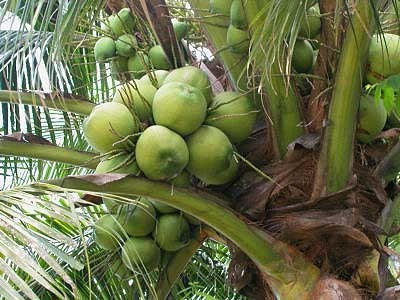
Common Name: Naarikela,
English Name: Coconut Palm
Botanical Name: Cocos nucifera Linn.
Family: Palmae; Areaceae
Description: The name Cocos probably derives from a Portuguese word meaning monkey, perhaps because its nut, bearing three germinating pores, resembles a monkey face. Its specific name derives from Latin, meaning nut-bearing. Coconut palms are medium-sized, solitary herbaceous plants. Although treelike in form, their trunks are composed not of wood, but of fibrous, stout, overlapping stems, and may grow to 25 m tall (80 feet), topped by a crown of pinnately compound leaves up to 4 meters (15 feet) long.
Chemical Constituents: Coconut water is a rich source of Potassium and other vitamins and minerals. Coconut oil contains fatty acids , Lauric, Caprylic, and Capric triglycerides.
Properties: Healthy scalp would mean healthy hair. Lauric acid converted into monolaurin is one of the antimicrobial properties of coconut oil. This acid is also found as ingredient in soaps and shampoo. By applying coconut oil, your scalp is kept moisturized and protected from fungi that cause dandruff. coconut oil also strengthens by holding your skin tissues together and protects the skin from the harmful UV rays of the sun. The antiseptic composition of coconut oil kills fungi and yeast that cause athlete's foot, diaper rash, and candidiasis. Coconut Oil is an excellent hair conditioner that softens hair while strengthening it and conditions the scalp preventing dandruff.
Used in the following MATXIN products: